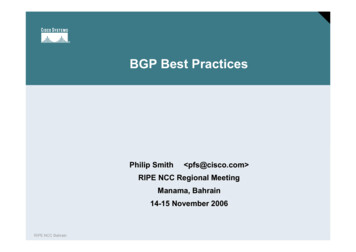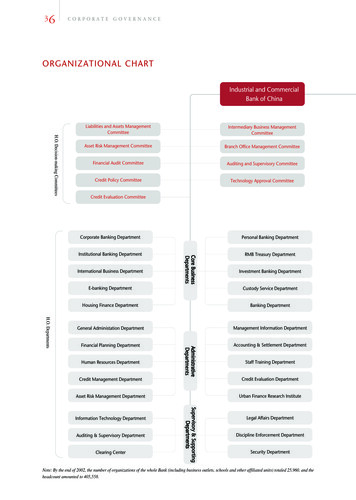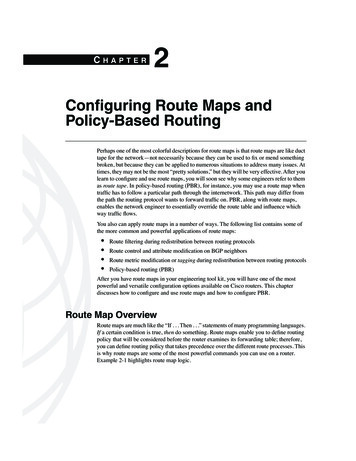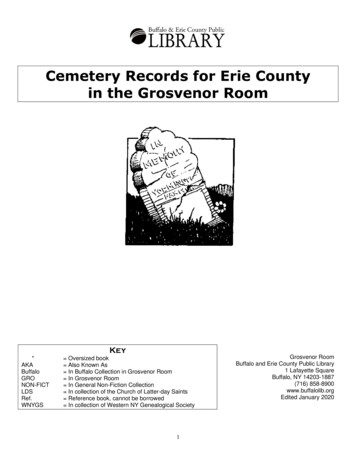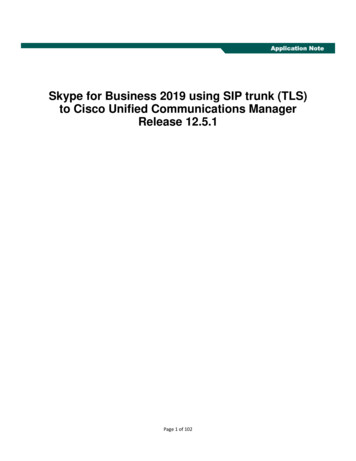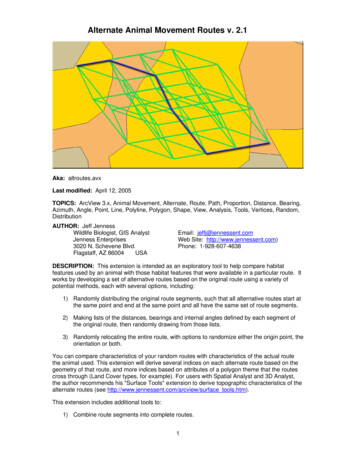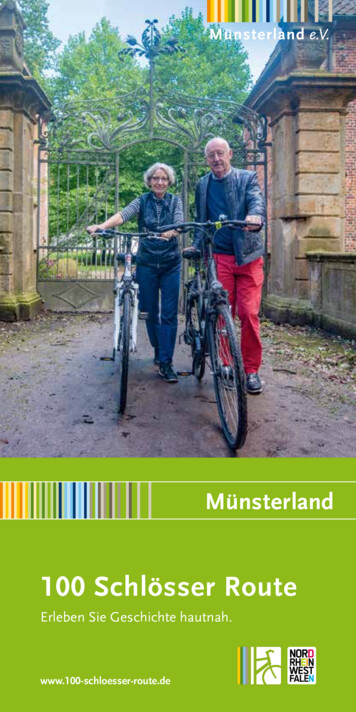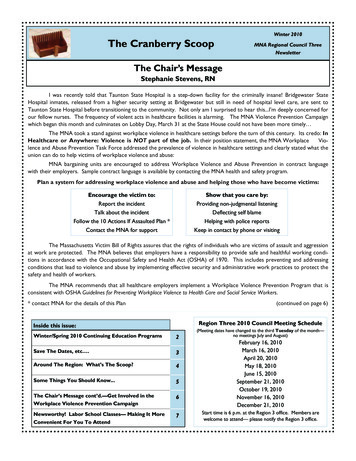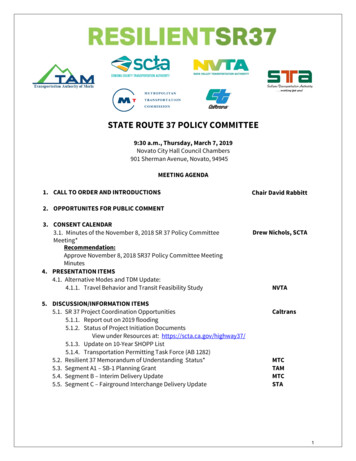
Transcription
STATE ROUTE 37 POLICY COMMITTEE9:30 a.m., Thursday, March 7, 2019Novato City Hall Council Chambers901 Sherman Avenue, Novato, 94945MEETING AGENDA1. CALL TO ORDER AND INTRODUCTIONSChair David Rabbitt2. OPPORTUNITES FOR PUBLIC COMMENT3. CONSENT CALENDAR3.1. Minutes of the November 8, 2018 SR 37 Policy CommitteeMeeting*Recommendation:Approve November 8, 2018 SR37 Policy Committee MeetingMinutes4. PRESENTATION ITEMS4.1. Alternative Modes and TDM Update:4.1.1. Travel Behavior and Transit Feasibility Study5. DISCUSSION/INFORMATION ITEMS5.1. SR 37 Project Coordination Opportunities5.1.1. Report out on 2019 flooding5.1.2. Status of Project Initiation DocumentsView under Resources at: https://scta.ca.gov/highway37/5.1.3. Update on 10-Year SHOPP List5.1.4. Transportation Permitting Task Force (AB 1282)5.2. Resilient 37 Memorandum of Understanding Status*5.3. Segment A1 – SB-1 Planning Grant5.4. Segment B – Interim Delivery Update5.5. Segment C – Fairground Interchange Delivery UpdateDrew Nichols, SCTANVTACaltransMTCTAMMTCSTA1
6. COMMITTEE MEMBER COMMENTS / STAFF UPDATESGROUP7. FUTURE TOPICSBay Area Regional Collaborative (BARC) – San Pablo Bay Active Transportation Access StudyAA for the Bay – restoration projects in San Pablo BaySTA – Ferry Study updateSMART – Feasibility Study updateMTC/Caltrans – Ultimate Environmental Phase Discussion8. ADJOURNMENTNext SR 37 Policy Committee Meeting: 9:30, Thurs., June 6, 2019 at a location to be determined.* Materials includedFuture Meeting Schedule (Pending Approval)9:30AM, Thursday, June 6, 20199:30AM, September 5, 20199:30AM, December 5, 2019SR 37 Policy Committee Members:SCTANVTATAMSTADavid Rabbitt, SonomaCountyBoard of SupervisorsJake Mackenzie, MTCCommissionerSusan Gorin, Sonoma CountyBoard of SupervisorsAlfredo Pedroza, MTCCommissionerBelia Ramos, Napa CountyBoard of SupervisorsLeon Garcia, Mayor City ofAmerican CanyonDamon Connolly, MTCCommissionerJudy Arnold, Marin CountyBoard of Supervisor sStephanie Moulton-Peters,Councilmember,City of Mill ValleyBob Sampayan, Mayor City ofVallejoJim Spering, MTCCommissionerErin Hannigan, Solano CountyBoard of SupervisorsMTCTherese McMillanExecutive DirectorCaltransTony TavaresDistrict 4 Director2
State Route (SR) 37 Policy Committee Meeting Minutes9:30 a.m., Thursday, November 8, 2018Foley Cultural CenterVallejo, CA 945921. Call to Order/IntroductionsChairman David Rabbitt called to order the State Route 37 Policy Committee at 9:30 a.m.Policy Committee Members Present:David RabbittChair, Supervisor, County of SonomaErin HanniganVice-Chair, Supervisor, County of SolanoJudy ArnoldSupervisor, County of MarinDamon ConnollyMTC Commissioner, Supervisor, County of MarinLeon GarciaMayor, City of American CanyonJake MackenzieMTC Commissioner, Councilmember, City of Rohnert ParkStephanie Moulton-Peters Councilmember, City of Mill ValleyAlfredo PedrozaMTC Commissioner, Supervisor, County of NapaBob SampayanMayor, City of VallejoJim SperingMTC Commissioner, Supervisor, County of SolanoPolicy Committee Members Absent:Susan Gorin, Supervisor, County of SonomaBelia Ramos, Supervisor, County of NapaExecutive Directors Present:Daryl Halls, Solano Transportation AuthorityKate Miller, Napa Valley Transportation AuthoritySuzanne Smith, Sonoma County Transportation AuthorityDianne Steinhauser, Transportation Authority of Marin3
Others Present:Alan GlenTY LinJoseph GreenHeffernResident- County ofSolanoErin HanfordCity of VallejoSissel HeberHNTBJason HolleyPublic Works, City ofAmerican CanyonKevin JohnsonFehr & PeersJohn KenyonTY LinSteve KinseyEngineering ContractorsAssociationAlta Planning and DesignInc.Tom LeaderTLS/RBDAdam BrandSCTA – CounselHouman MakarechiKleinfelderPatricia BrownResidentJohanna MasiclatSTAJames CameronSCTADan McElhinneyCaltransDavid CalsonESAAshley NguyenMTCFidel ChavezCarpenter’s UnionNick NguyenTAMKevin ChenMTCDrew NicholsSCTALauren ClarkCity of NapaDavid OsterFriends of SMARTBernadette CurrySTA – CounselElizabeth PattersonMayor, City of BeniciaJessica DavenportState CoastalConservatoryElizabeth PayanSMARTLeo Roy PfeiferSustainable NovatoLogan PittsOffice of Senator Bill DoddErik PrinceCommon GroundLee RosenblattCBGBarbara SalzmanMarin Audubon SocietyDanielle SchmitzNVTAShaveta SharmaNVTAFrasier ShillingUC DavisGrant SungarConsultantKaren TaylorCDFW-ESJanet AdamsSTAAnthony AdamsSTATanya AlbertCounty of MarinTom BarteeOffice of Senator Bill DoddDerek BeaudySF Regional Water BoardJames BezekCounty of SolanoSteve BirdleboughSonoma CountyTransportation and LandUse CoalitionJohn BlyFrancesca DemganJohn DiamanteNorth Rail & Multi UsePathways SystemAndrew DohrmannTY LinBill EmlenCounty of SolanoJean FinneyCaltransRick FraitesMarin Audubon SocietyAndrew FremierMTCMaureen GaffneyABAG Bay TrailSeana GauseSCTAHillary GitelmanESA4
FrancescaVantaggiatoUC DavisMare Island. It’s modeled the corridor will beunderwater in 30 years.Joy VillafrancaAECOMFurthermore, SR 37 houses a rich ecologicalhome to nine special-status species withsignificant acres of bay- and wetlands.2. Opportunities for Public CommentJohn Diamonte commented on the railwayassessments along the SR 37 Corridor. A seriesof handouts were provided for references.The first assessment in question is whether arailway linking Highway 101 and the othercorridors is the most ecological choice; second,would the cost of a railway be the leastexpensive compared to all alternatives, andlastly, Mr. Diamonte commented on whether arailway solution is the fastest alternative inwhich can be delivered.3. Consent Calendar3.1. Minutes of the July 20, 2018 SR 37Policy Committee MeetingThe minutes for the July 20, 2018 State Route 37Policy Committee were recommended, andapproved unanimously, following a motion byStephanie Moulton-Peters, and a second bySupervisor Judy Arnold.4. Presentation4.1. SR 37 Resilient Corridor ProgramAshley Nguyen and Kevin Chen, MTC, presentedto the committee the SR 37 Resilient CorridorProgram.Ms. Nguyen recalled The Corridor Plan thatprovides a birdseye view of the entire corridorand ideas suggested to move forward with.Segment B of the corridor has been identifiedas the priority segment and Ms. Nguyen recalledthat eastbound travel along the corridor duringcommute hours takes 100 minutesThere are six known weak links, some of whichflooded in 2017, that are prone to flooding –Petaluma River Levee, Port Sonoma, NovatoCreek and Day Island Road, Tubbs Island, andThe idea championed is to consider thecorridor, and bring all the elements, under onevision, one plan, and to be mindful of equityissues moving forward.The I-5 North Coast Corridor program in SanDiego, CA is viewed as an opportunity to learnfrom, a model, for the SR 37 corridor.This project has a 6 billion program to bedelivered over 40 years, including a half-centsales tax allowing a continuous revenue streamalongside federal, state, and local funding.Ms. Nguyen suggested the benefit this projectsbrings to SR 37 is the development of ablueprint which is available illustrating how theI-5 North Coast Corridor program will bedelivered. Components included in thismeasure are Highway Improvements, CoastalRail and Transit, and Environmental Protectionand Coastal Access; thus providing anopportunity to use as a model locally.The intent is to deliver an equitable corridorprogram that results in community benefits forall, including those who utilize the corridor foremployment and recreation.Highway 37 must become resilient to sea levelrise. The program’s purpose was described tothe committee.The resilient corridor program includes 5billion in funding in a 25 year time frame toaddress highway, transit, environment, publicaccess, and equity components which seek foran opportunity to make the SR 37 Corridoradaptive to sea level rise from Interstate 80 toHighway 101.There is also significant interest to alleviate thetraffic congestion via public transportation,such as the inclusion of a regional bus express5
system between Vallejo and Novato andSMART’s interest in an east-west expansion tothe Solano Hub that can help develop a robusttransit system along the corridor.MTC staff has been working closely with theenvironmental community over the past yearand half to understand their perspective of thecorridor that can allow natural resources to beprotected and restored.The Regional Advance Mitigation Planning(RAMP) aims to balance the needs oftransportation and conservation to maximizebenefits and provides a comprehensiveplanning framework to mitigate unavoidablebiological resource impacts caused as a resultof infrastructure projects.Ms. Nguyen further described the activelandscape enhancements that are currentlyunderway.Kevin Chen provided a description of interimcongestion relief projects for Segment B tobring the roadway up to standard.Given the serious bottlenecking that occurs onthis segment, the goal is to improve the corridorby reconfiguring the existing roadway to athree-lane facility, with a contraflow lane,similar to the Golden Gate Bridge. It was worthnoting that the time to move the barriers wouldtake upward to two hours.Additionally, modifications at the Tolay CreekBridge are identified to provide smoothertransitions.The second design alternative suggested is afour lane highway for Segment B using theshoulder as a part time lane similar to the thirdlane on the Richmond-San Rafael Bridge.Furthermore, intersection improvements at theHighway 121/37 intersection and Mare IslandInterchange were described as near-termoperational efficiency improvements. Ideasconsidered are a double lane roundabout atHighway 121/37 and a lane drop extension withramp metering at Mare Island.These projects can be delivered in three to fiveyears with an expected cost of 100-150 millionto deliver. The environmental process is hopedto begin next year with a cost of 8 million andPS&E cost of 12 million.The drivers of Highway 37 have a lot of benefits,primarily the reduction of 100 minutes of delayeastbound to 24 minutes; westboundcongestion delay would reduce from 47minutes to 23 minutes.Furthermore, improving the levy system isanother element considered. The intent is tostudy at more potential improvements toincrease the potential.In regards specifically to Segment B, betweenHighway 121 and Mare Island, five alternativeshave been identified; two of these suggestionsare along the current alignment:1.2.3.4.5.Current Alignment Hybrid Existing;Current Alignment Causeway;Northern Alignment;Southern Alignment (Shoreline);Southern Alignment (San PabloBay).Mr. Chen explained the evaluation metrics usedfor these various alternatives, noting therigorous evaluation criteria that wasestablished, and outlined the assessmentsummary.Alternative 3, Northern Alignment, wasregarded as the least favorable alternatives.The total construction costs are projected forall the alternatives to be between 2.4 and 3.3billion.Ashley Nguyen further added that the sea levelrise adaption project includes a separated Class1 bicycle lane to enhance safety.Resilient by Design, Common Ground, and MTChave received an SB-1 Planning Grant with hope6
to utilize for more public access through thecorridor.Ms. Nguyen championed the notion to bemindful of how to identify further funding andto consider the users of the corridor, and tocontinue exploring atypical partnerships.Ms. Nguyen commented on the partnershipsthat have been created via the SR PolicyCommittee, and advocated to expand furtherwith these visons.The recommendations for actions werehighlighted.Suzanne Smith, SCTA, reiterated the word andmeaning of “We” and the significance of thepolicy committee to address the corridor.Jake Mackenzie commented on importance ofthis project as Chair of MTC and reemphasizedthe importance of “We.”Chairman Rabbitt opened for public comment.Barbara Salzman commended MTC for the workand emphasized the importance of what isbeing completed, both short- and long term.Ms. Salzman advocated to continue looking forthe whole picture and the importance to tieadvanced mitigation to a specific project.Patricia Tuttle-Brown, an advocate for clean airand resident of the City of Petaluma, spoke onthe environmental challenges posed in thiscorridor and highlighted that air quality iscentral to all transportation issues.Regarding environmental issues, air quality isimportant to consider for wildlife andenvironmental access, to name a few. Pollutionemitting from cars is the biggest air qualityproblem and Ms. Brown further advocated onthe need for further funding and incentives tohelp the changes from single occupancydriving.Derek Beaudy, San Francisco Regional WaterQuality Control Board, thanked MTC staff forthe presentation. As a participant in theenvironmental working group, Mr. Beaudyspoke on benefits and appreciation for all theefforts that went into the working group.Mr. Beaudy further added:His agency’s goals including protection ofwaters for the Bay Area and the need to workcollaboratively to develop projects with theminimal environmental impacts. Given limitedavailable funding, short term fixes should helpplan for long term solutions for the corridor’svision and design.Specifically, while Segment B has beenidentified as the priority segment by theProject’s partners, we urge consideration of theentire corridor—Segments A, B, and C—duringthe environmental planning anddocumentation phase. This will help ensure acorridor-wide vision guides the design and thatthe long-term adaptation planning forSegments A and C will not be constrained bythe design of Segment B. Further, it should helpensure that money spent on short-term fixesalong Segment B either contributesappropriately to a longer-term fix, or is limitedto the minimum needed if the longer-term fix issomething different.We encourage the Project’s partners tocontinue to evaluate a full range of projectdesign alternatives with respect to not onlytheir transportation goals, but also with anunderstanding of their potential impacts to thesensitive Bay, wetland, and creek environmentsaround SR 37.Permittable project alternatives may not bealong the current alignment of SR 37. Thepreferred alternative must be the leastenvironmentally damaging practicablealternative that accomplishes the basic projectpurpose and avoids and minimizes direct andindirect impacts to the resources and processesthat support the beneficial uses of San PabloBay and its surrounding bayland habitats.7
Finally, any near-term traffic congestionprojects on Segment B will requireauthorization from the Water Board—likely aClean Water Act Section 401 certification—if theproject discharges fill into the Bay, wetlands, orother waters. We will work with you to considershort term designs, including mitigation for fill,clean water measures to address stormwaterrunoff from the project, and the short-termproject’s role in a longer-term fix. I would askthat you continue to keep us involved as projectplanning moves forward.Steve Birdlebough, Sonoma CountyTransportation and Land Use Coalition,commended the staff on this work, and waspleased to see the diamond lanes consideredalong the highway.Jessica Davenport, State Coastal Conservancy,thanked all staff involved in the analysis of thealternative alignments.Frasier Schilling, UC Davis, acknowledgedCaltrans staff present for their work and addedthere is a lack of academics in this process andspoke on the usefulness of academic opinionsin projects.5. Action Items5.1. MTC Regional Measure 3 Funding PlanSuzanne Smith described the Regional Measure3 funding plan.Ms. Smith explained the funding structurepresented, adding a plan needs to be submittedto Caltrans this month.The fund plan presented sets 15 million to STAfor Segment C – Fairgrounds Interchange, 20million to SCTA to pursue PAED and PS&E forSegment B, 4 million to SCTA for PAED forHighway 37/121 Improvements, 3 million forTAM to study the levees on Segment A, and 58million to SCTA/TAM for Segment A and Bimprovements.Stephanie Moulton-Peters, Dianne Steinhauser,and Chairman Rabbitt all providedcomplements and thanked all staff agencies forthe approach of the plan presented.In regards to transit options incorporated intothe plan, Kate Miller, NVTA, explained staff islooking into transit options, however thelegislation is loosely defined.The action requested is to authorize thesubmission of the request to MTC.Supervisor Jim Spering moved to accept thefunding plan and to authorize submission of theinitial request to MTC, Jake Mackenzieseconded. The motion was approvedunanimously.6. Information Items6.1. SR 37 Project CoordinationOpportunities6.1.1. Status of Project InitiationDocumentsJean Finney introduced Kelly Hirschberg to thecommittee as the new project manager for SR37.The 16 projects programmed along SR 37,Segment B, in the SHOPP were described, 15currently planned and programmed.A handout was provided to the committeemembers. Five projects are currently underpreparation for the 2020 SHOPP.The projects submitted are in alignment withMTC and Caltrans’ plans and staff continues tocoordinate with partnering agencies.Ms. Hirschberg stated that more informationwill be presented to the committee as itevolves.Supervisor Erin Hannigan, County of Solano,asked about absence of the Sacramento Streetentrance.Ms. Hirschberg responded that she will lookinto it and follow up with the information whenan answer is identified.Supervisor Judy Arnold, County of Marin, spokeon the absence of the Novato Creek flooding8
challenge and wondered why this was notincluded.understanding of the markets before the needsare determined.Ms. Finney responded that attempts were madeto include this in the 10-year plan, but due tocapacity challenges, this was tabled to beincluded in a future plan.The study suggests an on-demand, poolingoption, as opposed to a fixed route service.Supervisor Arnold further added that this is apressing issue that needs to be addressed nowand not in the future.Ms. Finney responded Caltrans has financialand performance targets that must be met andthis project was unable to meet those targets.Dan McElhinney added that he will look furtherinto this, suggesting with the defeat ofProposition 6, there may be an opportunity toadd projects. The CTC requests a renewal of theassess management plan every couple yearsand there are intentions to include NovatoCreek on the project list.Staff will continue to advocate for a higher levelof planning.6.1.2. Update on 10-year SHOPP ListDiscussed concurrently with Item 6.1.16.2. Alternative Modes Update6.2.1. NVTA – Bus Transit FeasibilityStudy presentation (draft)Kate Miller introduced Kevin Johnson with Fehrand Peers on the preliminary Bus TransitFeasibility Study and travel patterns on SR 37.The study included the introduction of smartphone data to establish existing drivingpatterns.The study’s purpose was to examine othermodes of travel aimed to relieve congestion,addressing equity concerns, and understandingthe demand and propensity to use fixed bus,micro-transit options.“Right sized transit” (i.e. Backbone, CrowdSourced, Door-to-Door) was the approach used,stating that one type of transit does not serveall needs. However, there needs to be anThe key findings of the origin and destinationswere described, including residents of SolanoCounty accessing jobs in Marin and SonomaCounties, most drivers are driving longdistances for work-related trips, most driversearn at, or below, the median income, andsome bus opportunities exist, although microtransit and pooling options best serve others.Mr. Johnson explained how the traffic countdata was collected and the results found.In terms of usage, the AM westbound commuteis primarily residents of Solano County;Sonoma Highway is predominantly used byresidents in Napa County.When considering the propensity for takingtransit, service from Sonoma (city) to Vallejo,San Rafael to Vallejo, and Novato to Vallejoranked the highest.The next steps described revolve aroundunderstanding the approaches for transit onthe corridor, be it an express bus, micro-transit,and/or park and pool.Chairman Rabbitt opened the floor for publiccomment:Patricia Tuttle-Brown quoted, “a developedcountry is not where the poor have cars, butwhere the rich take public transportation.” Ms.Brown further spoke on these plans for publictransportation.Steve Birdlebough expressed appreciation onthe level of detail in the presentation andwondered how individuals will access transit,bicycles, and scooters.6.2.2. SMART – Feasibility Study updateSuzanne Smith briefly updated the committeeon SMART’s plan to pursue an engineeringanalysis of East-West service to assess viability.9
This is a preliminary step and the draft study isanticipated late next year.7. CorrespondenceCorrespondences were included in the agendapacket.8. Committee Comments and Staff updatesN/A9. Future TopicsThe future topics include: BARC – San Pablo Bay ActiveTransportation Access Study STA – Ferry Study update Environmental Phase Discussion:o Segment B Interimo Segment A &B Ultimate10. AdjournmentThe committee adjourned at 11:20 a.m.10
MEMORANDUM OF UNDERSTANDINGforTHE RESILIENT STATE ROUTE 37 PROGRAMbetweenBAY AREA TOLL AUTHORITYCALIFORNIA DEPARTMENT OF TRANSPORTATIONSOLANO TRANSPORTATION AUTHORITYSONOMA COUNTY TRANSPORTATION AUTHORITYTRANSPORTATION AUTHORITY OF MARINNAPA VALLEY TRANSPORTATION AUTHORITYThis Memorandum of Understanding (MOU) is entered into and effective as of the last datewritten below between the Bay Area Toll Authority (“BATA”), California Department ofTransportation District 4 (“Caltrans”), the Solano Transportation Authority (“STA”), the SonomaCounty Transportation Authority (“SCTA”), Transportation Authority of Marin (“TAM”) andNapa Valley Transportation Authority (“NVTA”) (referred to herein collectively as the “Parties”or individually as a “Party”), to cooperatively determine their mutual responsibilities indelivering the Resilient State Route 37 Program (“Program”).Recitals1. The Resilient SR 37 Program aims to address resiliency of transportationinfrastructure to sea level rise and flooding, traffic congestion, and opportunities forecological enhancements, transit, multimodal use and public access along the SR 37corridor from I-80 to US 101. The Program includes near- and longer-termimprovements for a majority of the 20-mile corridor, including the long-term sealevel rise vulnerability of a number of low-lying areas throughout the corridor.2. The SR 37 Policy Committee, Executive Steering Committee (“ESC”) and the ProjectLeadership Team (“PLT”) currently have varying roles and responsibilities in thedevelopment and delivery of the Program. The SR 37 Policy Committee, composedof Executive Directors and Board Members representing BATA, Caltrans, STA,SCTA, TAM, and NVTA, provides policy oversight and dispute resolution to therespective staffs. The Executive Directors of BATA, Caltrans, STA, SCTA, TAM,and NVTA serve on the ESC to provide strategic direction to the Policy Committeeand PLT. The Directors and their staffs of BATA, Caltrans, STA, SCTA, TAM, andNVTA participate in the PLT to vet technical, policy, and other related project issuesand elevate them as appropriate to the ESC.3. The BATA, Caltrans, STA, SCTA, TAM and NVTA completed a SR 37Transportation and Sea Level Rise Corridor Improvement Plan that identifiedSegment B between and including Sears Point to the Mare Island Bridge (referred toherein as the “Segment B”) as the highest priority. On November 2, 2017, the SR 37Policy Committee confirmed that Segment B is the priority segment. Subsequently,BATA, STA, SCTA, TAM and NVTA prepared a Project Initiation Document (PID)11
BATA/Caltrans/STA/SCTA/TAM/NVTAMemorandum of UnderstandingResilient SR 37 Programfor Segment B improvements and submitted it to Caltrans for review and approval.Caltrans approved this PID on December 28, 2018.4. On November 8, 2018 the SR 37 Policy Committee unanimously approved a fundingplan and authorized the applicable sponsor(s) to submit Initial Project Reports to theMetropolitan Transportation Commission for funding consideration under RegionalMeasure 3, as follows: 15 million to STA for Segment C-Fairgrounds Interchange, 20 million to SCTA for Interim Segment B Environmental and Design Phases, 4million to SCTA for Environmental Phase for SR 37/121 improvements, 3 million toTAM for Segment A levee study, and 58 million to SCTA and TAM for UltimateSegment A and Segment B improvements.5. The Parties wish to organize the delivery of the SR 37 Program wherein:a. BATA, Caltrans, SCTA and TAM is assigned to and have purview overSegment A (US 101 to SR121);b. BATA, Caltrans, SCTA, STA and NVTA is assigned to and have purviewover Segment B (Sears Point to Mare Island Bridge); andc. BATA, Caltrans, and STA is assigned to and have purview over Segment C(Mare Island Bridge to I-80).The SR 37 Policy Committee, ESC and PLT continue to perform the same roles andresponsibilities except for the technical work, discussions, actions and decisions ofthe individual Party would be targeted and applicable to the project segment forwhich that Party is assigned.6. The Parties commit to continue to make progress on the delivery of the prioritySegment B interim and ultimate projects, while also performing feasibility studies,environmental studies, PIDs, and related studies with the goal of coordinating thelonger-term delivery of the SR 37 Program.7. A Party intends to seek legislation to amend Section 30910 of the Streets & HighwayCode for the Sears Point-Mare Island Bridge to become a State-owned bridge, joiningthe toll bridge financial enterprise administered by BATA.8. The Parties acknowledge the likely need for funding above and beyond toll bridgeenterprise funding administered by BATA, and as such, intend to develop a financingand funding plan consisting of other traditional and untraditional funding sources todeliver the Program.9. The Parties wish to work cooperatively to deliver the Program by exploringalternative project delivery methods (including, but not limited to, Design Buildcontracts), early environmental enhancements, and traditional and non-traditionalfunding and partnerships.212
BATA/Caltrans/STA/SCTA/TAM/NVTAMemorandum of UnderstandingResilient SR 37 ProgramI.TermThe term of this MOU shall commence when fully executed, and unless amended earlier,shall terminate at a date agreed upon by the Parties.II.SR 37 Program Delivery OrganizationA. Executive Steering Committee (ESC)1. RoleThe ESC shall guide the identification, development, funding plan andimplementation of projects to improve State Route 37. The ESC will select aChairperson. The Chairperson will rotate between the members every two years.The Chairperson shall preside over the meetings of the ESC and shall perform allother duties incident to the position or as assigned to her or him by the ESC.2. Membersa. Executive Director, BATA (or designee)b. District 4 Director, Caltrans (or designee)c. Executive Director, STA (or designee)d. Executive Director, SCTA (or designee)e. Executive Director, TAM (or designee)f. Executive Director, NVTA (or designee)3. Assignmenta. Segment A: BATA, Caltrans, SCTA, TAMb. Segment B: BATA, Caltrans, SCTA, STA, NVTAc. Segment C: BATA, Caltrans, STA4. Responsibilitiesa. Approve implementation and funding plan(s), which may include one ormore projects.b. Define agency roles and responsibilities for individual projects, includingproject managers.c. Approve the scope, schedule, budget and funding plan for individualprojects within funding levels approved by the BATA or other fundingagencies, as applicable.d. Oversee overall project progress and reporting of project status, riskassessments, costs and schedule.e. Advise the BATA on contract matters.f. Review and approve project staffing plans.5. Decision-makingThe ESC will endeavor to make decisions on a consensus basis. To ensure publicaccountability, transparency and public disclosure, the decisions will be documented.313
BATA/Caltrans/STA/SCTA/TAM/NVTAMemorandum of UnderstandingResilient SR 37 Program6. MeetingsRegular meetings of the ESC shall be held quarterly as otherwise determined by theESC. Notice shall include an agenda of items on which the ESC will take action. Eachmember of the ESC has the right to place a matter on the ESC's agenda forconsideration. Meetings to be rotated between BATA, Caltrans, STA, SCTA, NVTA,TAM offices or at a location determined by the ESC.B. Corridor Director of the ESC1. The Corridor Director serves as staff to the ESC, represents all ESC membersand works directly with member agency Executive Directors and their staffs.a. BATA will select, with the ESC, and employ the Corridor Director.b. BATA reserves the right to make decisions regarding hiring, promotion,termination, compensation, and removal of the Corridor Director, inconsultation with the ESC.c. The Corridor Director may serve the SR37 Corridor Policy Committee ina similar capacity.2.ResponsibilitiesThe Corridor Director shall work with the Project Leadership Team, collaborateand provide direction to the project managers, as appropriate, toa. Develop a implementation plan(s) and funding plan(s), including deliverymethodsb. Develop the scope, schedule, budget and funding plan for individualprojects.c. Report regularly to the ESC on project status, risks assessments, change,costs and schedule.d. Develop project staffing plans.e. Prepare agendas for ESC meetings.f. Deliver progress reports to and consult with the SR 37 Corridor PolicyCommittee.g. Deliver progress reports to ESC and Policy Committee.h. Provide oversight and direction to project managers.The Corridor Director will also advise the SR37 Corridor Policy Committee onthe SR 37 program.C. Project Leadership Team1. RoleThe ESC herby establishes a Project Leadership Team (PLT) that shall assist theESC in the performance of its duties. The members of the PLT shall advise theCorridor Director on matters that are to be br
AA for the Bay - restoration projects in San Pablo Bay . STA - Ferry Study update . SMART - Feasibility Study update . . David Rabbitt Chair, Supervisor, County of Sonoma Erin Hannigan Vice-Chair, Supervisor, County of Solano Judy Arnold Supervisor, County of Marin Damon Connolly MTC Commissioner, Supervisor, County of Marin .

